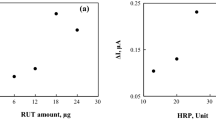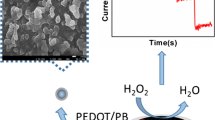Abstract.
A novel hydrogen peroxide biosensor was developed based on the immobilization of horseradish peroxidase (HRP) in a TiO2 sol-gel matrix on an electropolymerized phenazine methosulfate (PMS) modified electrode surface. Such membranes are of interest due to their high surface area, biological compatibility, and ease of fabrication. HRP entrapped in the TiO2 matix was stable and retained its activity to a large extent. Cyclic voltammetry and amperometric measurements were employed to demonstrate the feasibility of electron transfer between immobilized HRP and the glassy carbon electrode via electropolymerized PMS. The influence of various experimental parameters such as operating potential, pH, temperature, and stability was investigated for optimum analytical performance. The biosensor provided a wide linear calibration range from 4.0×10–6 M to 1.0×10–3 M, with a detection limit of 8.0×10–7 M at a signal-to-noise ratio of 3. The sensor retained 80% of its original activity after two months of operation.
Similar content being viewed by others
Author information
Authors and Affiliations
Additional information
Electronic Publication
Rights and permissions
About this article
Cite this article
Xu, X., Zhao, J., Jiang, D. et al. TiO2 sol-gel derived amperometric biosensor for H2O2 on the electropolymerized phenazine methosulfate modified electrode. Anal Bioanal Chem 374, 1261–1266 (2002). https://doi.org/10.1007/s00216-002-1616-0
Received:
Revised:
Accepted:
Published:
Issue Date:
DOI: https://doi.org/10.1007/s00216-002-1616-0




